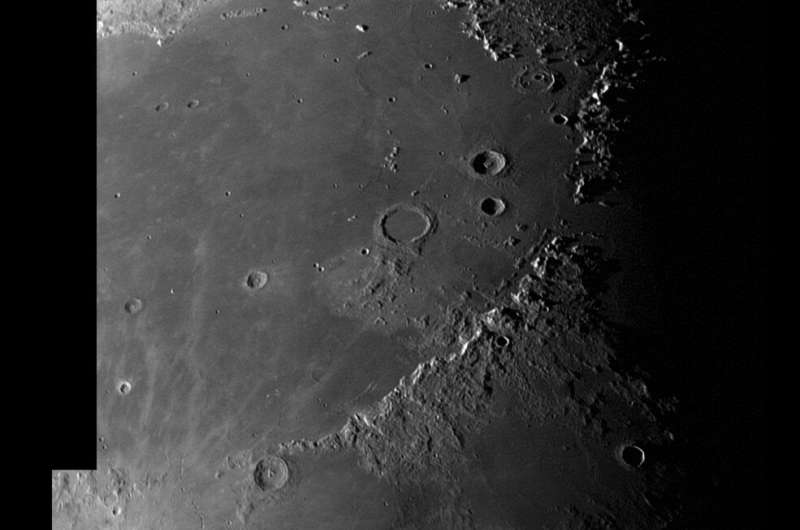Still image of the Lunar Central Highlands Credit: NASA/Goddard/SwRI/JHU-APL/Tod R. Lauer (NOIRLab)
NASA’s Lucy spacecraft captured this image of the lunar surface on October 16, 2022, about 6.5 hours after it flew past Earth for its first of three gravity assists. The image was taken when Lucy was between the Earth and the Moon, approximately 260,000 km from the Moon, and therefore shows a perspective familiar to observers on Earth. The image shows an 800 mile (1200 km) wide patch near the center of the Moon’s last quarter. Many known craters are visible, including the relatively fresh Arzachel crater just left of center. The prominent fault escarpment called the Straight Wall cuts through the lava plains at lower center left.
The image, created by combining ten separate 2ms exposures of the same scene to maximize image quality, has been sharpened. Each pixel is approximately 1.3 km (0.8 miles).
This image was captured with L’LORRI (Lucy LOng Range Reconnaissance Imager), Lucy’s high-resolution grayscale imager. L’LORRI was provided and operated by the Johns Hopkins Applied Physics Laboratory.
Terminator Mosaic

Image credit: NASA/Goddard/SwRI/JHU-APL/Tod R. Lauer (NOIRLab)
NASA’s Lucy spacecraft captured this mosaic of the lunar surface on October 16, 2022, between 7.5 and 8 hours after passing Earth for its first of three gravity assists. At its closest approach, the flyby brought the spacecraft within 224 miles (360 km) of Earth and flew below the level of the International Space Station. Lucy was an average of about 140,000 miles (230,000 km) from the Moon when these images were taken.
The mosaic was taken when Lucy was between the Earth and the Moon, so it shows a perspective familiar to Earth-based observers, centered near the Moon’s last quarter terminator. The view includes the rugged, heavily cratered Southern Highlands at the bottom of the mosaic and the ancient, lava-filled Mare Imbrium impact basin at the top. Bright, fresh crater Copernicus is prominent on the left edge of the mosaic.
This mosaic, made up of 5 separate 1ms exposures, has been sharpened. Note that the image covering the top part of the lunar rim was taken earlier, resulting in a small discrepancy in the images there. Each pixel represents approximately 0.7 miles (1.2 km).
Single frame by Mare Imbrium

Image credit: NASA/Goddard/SwRI/JHU-APL/Tod R. Lauer (NOIRLab)
NASA’s Lucy spacecraft captured this image of the lunar surface on October 16, 2022, about 8 hours after it flew by Earth for its first of three gravity assists. The image was taken when Lucy was between the Earth and the Moon, so it shows a perspective familiar to observers on Earth. The image shows a strip of lunar terrain about 600 miles (1000 km) wide, dominated by the ancient lava-filled Mare Imbrium impact basin. The Apennines, part of the rim of the Imbrian Basin, which was the landing site of the Apollo 15 mission in 1971, dominate the lower right part of the image. Lucy was about 140,000 miles (230,000 km) from the moon when the image was taken.
The image, which is a single 1ms exposure, has been sharpened. Each pixel represents approximately 0.7 miles (1.1 km).
The Lucy spacecraft is taking pre-gravity assist images of the Earth and Moon
Citation: Images: NASA’s Lucy Spacecraft Offers New Views of the Moon (2022, October 27) Retrieved October 27, 2022 from https://phys.org/news/2022-10-images-nasa-lucy-spacecraft- views.html
This document is protected by copyright. Except for fair trade for the purpose of private study or research, no part may be reproduced without written permission. The content is for informational purposes only.
#Images #NASAs #Lucy #spacecraft #offers #views #moon


Leave a Comment